Page
14: Whitehorse
Whitehorse
was a different experience from our other postings in many ways. Its
physical surroundings were reminiscent of Jasper and Banff - rushing
rivers, picturesque lakes, mountain ranges, and forests of fir and
spruce trees. But its people were different. Between 1896 and 1904
$100 million in gold was extracted from the Klondike creeks' placer
deposits. Memories of the gold rush days were still vivid to the people
of the Yukon. In Whitehorse itself, many reminders of those days remained.
The
Sternwheelers
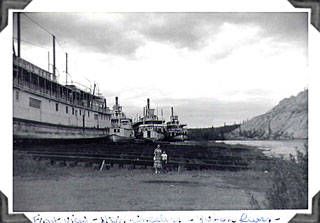
Sternwheelers beside the Yukon River, Whitehorse, 1959.
Downtown, laid up along the riverbank not far from the railway station,
were four old stern-wheel steamers: the Casca, Klondike, Whitehorse,
and Keno. Before the Highway was built, they had been the main method
of transportation for people and goods to and from the settlements
along the rivers. As well as prospectors, other travellers, and stores,
they carried mined ores to be processed in the south. When the improved
route south created by the Highway made river transport obsolete,
the ships' owners, the British Yukon Navigation Company, laid the
Casca up on shore in 1952 and the Whitehorse in 1955. They presented
them to the federal government in 1959.
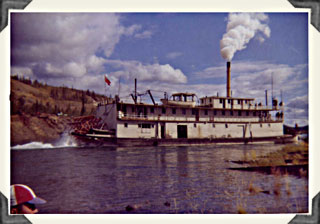
Last voyage of the Keno, August 25, 1960.
Much
excitement was generated in August 1960, when the Keno, the smallest
of the sternwheelers at 613 tons, was re-floated and steamed downriver
to Dawson City. It was the last voyage by a sternwheeler until the
Klondike was re-floated to make the trip in 1966. Most of the population
of Whitehorse gathered to watch the old-timer start the journey down
the Yukon River.
The
Keno, built in 1922 and originally used to haul silver, lead, and
zinc ores down the Stewart River, was chosen to make the journey because
it was the smallest of the ships and the one considered most up to
the task. It was the other, larger steamers, the Casca (1898) and
the Whitehorse (1901), that had once shuttled between Whitehorse and
Dawson City, but in 1960 they were not in good enough condition to
make the trip again. Unfortunately the Casca and the Whitehorse were
destroyed by fire in 1974, but the Klondike and the Keno still survive
in Dawson City.
Reminders
of the Past
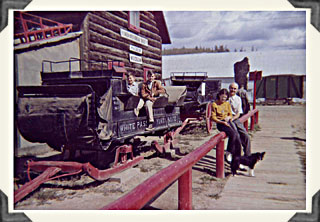
MacBride Museum, Whitehorse, August 26, 1960: Ian, Chris, Jill, Dick,
Trixie
The
little MacBride Museum held many relics of the Trail of '98 housed
in a log building, built in 1900, that had been the first government
telegraph office in Whitehorse. The museum, managed by the Yukon Historical
Society, was on First Avenue, almost opposite the White Pass and Yukon
Railway station. It was also not far from the sternwheelers laid up
on the riverbank.
Around
the building stood a number of interesting objects that had played
a part in the colourful history of the Yukon. At one of the corners
of the lot stood an immense sheet of copper standing on end, looking
rather like a modern sculpture. It was an apt reminder of the discovery
of the Whitehorse copper belt in 1897, just west of Whitehorse, and
of this mineral's great importance to the territory.
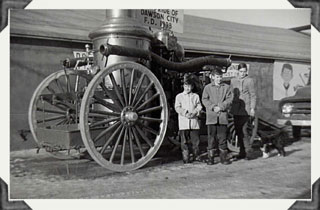
"The Pride of Dawson City F.D. 1898" (1961)
At
17 Works Company area we saw another relic, a wonderful old fire engine
that the Royal Canadian Engineers had repaired and reconditioned.
In the country around Whitehorse were many other vivid reminders of
the overwhelming task it must have been for those long-gone cheechakos
to get themselves and their supplies to the land where they hoped
to make their fortunes. At Carcross, southwest of Whitehorse, the
SS Tutshi was laid up on dry land. This sternwheeler once conveyed
prospectors of the nineties across Lake Bennett, en route to the goldfields.
Beside the Tutshi was another relic of those past travellers, a locomotive
named The Duchess.
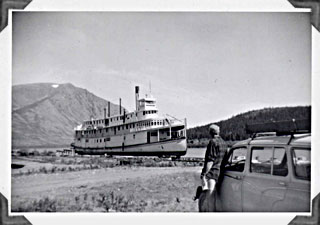
SS Tutshi, Carcross, Yukon Territory, 1960
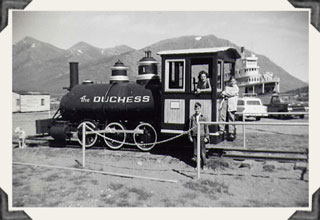
The
Duchess, Carcross, Yukon Territory, 1960
Beside
the railway engine was one more example of a means of transportation
in the nineties: a wagon used for carrying the Royal Mail, its inscription
revealing that it was part of the White Pass and Yukon Railway route.
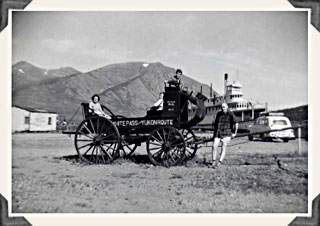
Royal
Mail wagon, Carcross, Yukon Territory, 1960
Christ
Church Cathedral
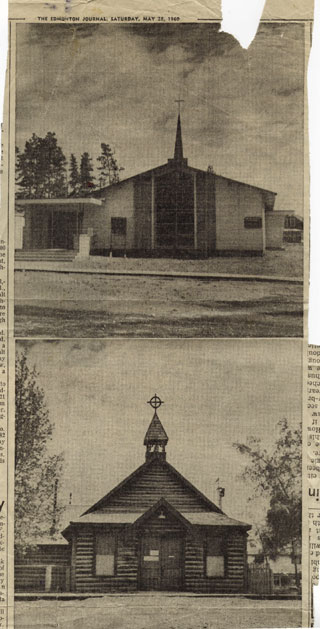
Christ Church Cathedral, new and old, Whitehorse, 1960 (The Edmonton
Journal, May 28, 1960)
Although Camp Takhini had the usual complement of army padres, we
were encouraged to join a local church, should there be one of the
appropriate denomination, in Whitehorse. We duly joined Christ Church
Cathedral, which was in the process of replacing its charming old
log building with a new brick-and-glass edifice. The new building's
design was reminiscent of its predecessor, and it would eventually
replace the decaying older structure.
The
first Anglican services in Whitehorse were held in a tent in August
1900, during the gold rush years, when a mission was established there.
By October of the same year, enthusiastic local inhabitants had built
the log cathedral. The present-day version was completed and dedicated
in 1960. Although we appreciated its splendid modernity, we missed
the comfortable old charm of the log version.
The Protestant army padre, although no longer responsible for the
spiritual welfare of those who had joined local churches, was able
to provide an invaluable service whether we were still in his flock
or not. He was an expert on mushrooms, and as these grew in vast quantities
around the neighbourhood, we were all avid mushroom hunters - "shaggy
manes" being a favourite variety, as they were particularly good
eating. If we were unsure whether what we had picked was safe to eat,
Padre Alfred's invaluable expertise could provide the answer. Even
when not engaged in saving our souls, he possibly saved quite a few
lives!
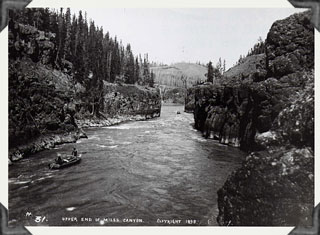
Upper end of Miles Canyon, 1898 (E.A. Hegg)
Miles Canyon
At
Mile 911.8 on the Highway, a small secondary road led visitors to
Miles Canyon, through which the Yukon River rushes with great force.
It was another place with strong connections to gold rush days and,
incidentally, a pleasant place to take the children for a picnic.
The
canyon was part of the route downriver to Whitehorse from Lake Bennett,
where the gold-seekers bought or built the boats and rafts in which
they would attempt the river passage. By June 1898 nearly three hundred
boats had been wrecked along the Yukon River between Miles Canyon
and the Whitehorse Rapids, and five people had been drowned. The turbulent
water of the river, as it rushed through the narrow space between
the high, rocky canyon walls, must have been a daunting sight to the
men in their small craft. As we stood on the little white bridge that
recently had been built across the narrowest part of the canyon, it
was easy to realize just how perilous the trip must have been for
those hopeful voyagers.
So
dangerous was the river trip that Inspector Sam Steele of the North-West
Mounted Police issued an order that, if boats were used on this stretch
of the Yukon, skilled pilots had to be hired to run the passage. To
overcome the difficulties of the dangerous waters, a log tramway was
built to move the miners and their supplies, running from Canyon City,
above the canyon, to Whitehorse.
Next
Posting
In
August 1961 Dick was promoted and posted back to Winnipeg, to his
former unit at HQ Prairie Command. In the usual way of army life,
although pleased to be returning to old friends and familiar places,
we could not help but feel regret for loss of the friends we had made
in Whitehorse. And we could not help but miss the town itself and
the wonderful country of the Yukon.
Living
in furnished quarters made moving an easy matter. The few things that
we had brought with us and did not need on our journey were soon packed
and dispatched to the warehouse in Winnipeg where our own furniture
was in storage. We were officially "marched out" of our
quarters and set off, not in a southerly direction but quite the opposite
- towards the north. There was one more place in the Yukon that we
wanted to visit before we left.
[Next
Page]
Pages: [1]
[2] [3]
[4] [5]
[6] [7]
[8] [9]
[10] [11]
[12] [13] [14] [15]
[16]
Return to top of
page
Return to the Watts
Family page